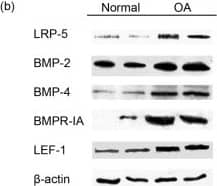Human BMP-4 Antibody
R&D Systems, part of Bio-Techne | Catalog # AF757


Key Product Details
Species Reactivity
Validated:
Cited:
Applications
Validated:
Cited:
Label
Antibody Source
Product Specifications
Immunogen
Ser293-Arg408
Accession # P12644
Specificity
Clonality
Host
Isotype
Endotoxin Level
Scientific Data Images for Human BMP-4 Antibody
Alkaline Phosphatase Production Induced by BMP-4 and Neutralization by Human BMP-4 Antibody.
Recombinant Human BMP-4 (Catalog # 314-BP) induces alkaline phosphatase production in the the ATDC5 mouse chondrogenic cell line in a dose-dependent manner (orange line). Alkaline phosphatase production elicited by Recombinant Human BMP-4 (15 ng/mL) is neutralized (green line) by increasing concentrations of Goat Anti-Human BMP-4 Antigen Affinity-purified Polyclonal Antibody (Catalog # AF757). The ND50 is typically 0.5-2.0 µg/mL in the presence of heparin (2 µg/mL).Detection of BMP-4 by Western Blot
Low-density-lipoprotein receptor-related protein (LRP)-5, BMP-2, BMP-4, BMP-7, BMPR-IA, BMPR-IB, LRP-6, phospho-beta -catenin, LEF-1, and TCF-4 expression in normal and osteoarthritic chondrocytes. (a) Quantitative LRP-5, BMP-2, BMP-4, BMP-7, BMPR-IA, BMPR-IB, LRP-6, LEF-1, and TCF-4 expression in normal and osteoarthritic chondrocytes. The results showed that LRP-5 (fourfold), BMP-2 (fourfold), BMP-4 (threefold), BMPR-IA (twofold), and LEF-1 (4.5-fold) mRNA expression was significantly increased in osteoarthritic chondrocytes compared with normal. (Error bars, SEM; standard errors, *P < 0.05). (b) LRP-5, BMP-2, BMP-4, BMPR-IA, and LEF-1 protein expression in normal and osteoarthritic chondrocytes after Western blot analysis. The results showed that LRP-5, BMP-2, BMP-4, BMPR-IA, and LEF-1 protein expression was significantly increased in osteoarthritic chondrocytes compared with normal. beta-actin was used as internal control. (c) Bar graph showing the LRP-5, BMP-2, BMP-4, BMPR-IA, and LEF-1 protein levels in normal (n = 5) and osteoarthritic chondrocytes (n = 11). (Error bars, SEM; standard errors, *P < 0.05). (d) Expression of BMP-2 in normal and osteoarthritic cartilage after immunohistochemistry experiments. (e) Western blot analysis showed a significant reduction of phospho-beta -catenin protein levels in osteoarthritic chondrocytes compared with normal. (f) Bar graph showing the phospho-beta -catenin protein levels in normal (n = 5) and osteoarthritic chondrocytes (n = 11). (Error bars, SEM; *P < 0.05). Image collected and cropped by CiteAb from the following open publication (https://pubmed.ncbi.nlm.nih.gov/22513174), licensed under a CC-BY license. Not internally tested by R&D Systems.Applications for Human BMP-4 Antibody
Western Blot
Sample: Recombinant Human BMP-4 (Catalog # 314-BP)
Neutralization
Formulation, Preparation, and Storage
Purification
Reconstitution
Formulation
Shipping
Stability & Storage
- 12 months from date of receipt, -20 to -70 °C as supplied.
- 1 month, 2 to 8 °C under sterile conditions after reconstitution.
- 6 months, -20 to -70 °C under sterile conditions after reconstitution.
Background: BMP-4
BMP-4 is a TGF-beta superfamily ligand that is widely expressed from early embryogenesis through adulthood. It plays an important role in mesenchyme formation, epidermal determination, suppression of neural induction, the development of multiple organs, and tissue repair (1 - 5). The human BMP-4 precursor contains a 273 amino acid (aa) propeptide and a 116 aa mature protein (6). Processing of the propeptide by furin or proprotein convertase 6 enables the formation of the mature disulfide-linked homodimeric BMP-4 and facilitates its secretion. Similar intracellular processes may lead to the formation and recreation of BMP4/BMP7 disulfide-linked heterodimer (7 - 9). Mature human and mouse BMP-4 share 98% aa sequence identity. Human BMP-4 shares 85% aa sequence identity with human BMP-2 and less than 50% with other human BMPs. Compared to BMP-4 homodimers, BMP-4/BMP-7 heterodimers exhibit a greater potency in inducing osteogenic differentiation (9). In Xenopus, the heterodimers can also induce the formation of mesoderm, whereas BMP-4 homodimers only provide ventralizing signals for existing mesoderm (10). BMP-4 signals through tetrameric complexes composed of type I (primarily Activin RIA or BMPR‑IA) and type II (primarily Activin RIIA or BMPR-II) receptors (11, 12). The bioavailability of BMP-4 is regulated by its interaction with multiple proteins and glycosaminoglycans (13 - 15).
References
- Zhang, P. et al. (2008) Blood 111:1933.
- Gambaro, K. et al. (2006) Cell Death Differ. 13:1075.
- Simic, P. and S. Vukicevic (2005) Cytokine Growth Factor Rev. 16:299.
- Sadlon, T.J. et al. (2004) Stem Cells 22:457.
- Frank, D.B. et al. (2005) Circ. Res. 97:496.
- Wozney, J. et al. (1988) Science 242:1528.
- Cui, Y. et al. (1998) EMBO J. 17:4735.
- Cui, Y. et al. (2001) Genes Dev. 15:2797.
- Aono, A. et al. (1995) Biochem. Biophys. Res. Commun. 210:670.
- Nishimatsu, S. and G.H. Thomsen (1998) Mech. Dev. 74:75.
- Chen, D. et al. (2004) Growth Factors 22:233.
- Lavery, K. et al. (2008) J. Biol. Chem. April 24 epub.
- Rosen, V. (2006) Ann. N.Y. Acad. Sci. 1068:19.
- Jones, C.M. and J.C. Smith (1998) Dev. Biol. 194:12.
- Takada, T. et al. (2003) J. Biol. Chem. 278:43229.
Long Name
Alternate Names
Gene Symbol
UniProt
Additional BMP-4 Products
Product Documents for Human BMP-4 Antibody
Product Specific Notices for Human BMP-4 Antibody
For research use only
